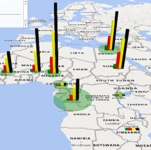- What are heat waves (extreme heat) like?
- The place-specific causes – the extreme weather conditions which led to the event
- The consequences of heatwaves for people and place
- The Responses to an Extreme Weather Event in the UK
Resources
Cambridge temperature data worksheet
2022 heatwave – consequences for people and place worksheet
Heat waves and climate change worksheet
Knowledge Organiser: 2022 Heatwave in Cambridge Case Study
























